A Spatial-Temporal Analysis of the Effects of Households’ Land-use Behaviors on Soil Available Potassium in Cropland: A Case Study from Urban Peripheral Region in Northeast China
Abstract
1. Introduction
2. Conceptual Framework
3. Materials and Methods
3.1. Study Areas
3.2. Data Collection and Processing
3.2.1. Soil Observations
3.2.2. Socioeconomic Data
3.3. Methodology
3.3.1. Geostatistical Analysis Methodology
3.3.2. Econometric Model Construction
4. Results
4.1. Temporal and Spatial Evolution Characteristics of AVK
4.1.1. Temporal Evolution Characteristics of Soil AVK
4.1.2. Spatial Distribution Characteristics of Soil AVK
4.2. Households’ Land-Use Behaviors Change over Time and its Effect on Soil AVK
4.2.1. Households’ Land-Use Behaviors Change over Time
Land-Use Type Change over Time
Land Use Degree Change over Time
Land Input Intensity Change over Time
4.2.2. Impact of Households’ Land-Use Behaviors on Temporal Evolution on AVK
4.3. Temperal Evolution of Households’ Land-Use Behaviors and its Effect on Soil AVK
4.3.1. Spatial Variation of Households’ Land-Use Behaviors
Spatial Variations of Land Use Type
Spatial Evolution of Land Use Degree
Spatial Evolution of Land Input Intensity
4.3.2. Empirical Results of the Impact of Households’ Land-Use Behavior in Spatial Evolution on AVK
5. Discussion
6. Conclusions
- (1)
- Although the AVK content of the soil in the study area has a largely downward trend in the past 30 years, there are different trends in different stages. This variation can be attributed to to the gradual evolution of households’ land-use behaviors. From 1980 to 2000, the average value of AVK decreased from 149.56 mg/kg to 103.52 mg/kg, due to the underdeveloped economy, limited investment capacity, technology level, and management level, as well as the plunder of cropland. After the year 2000, with the acceleration of the urbanization process and driven by economic interests, households gradually seek to maximize profits by increasing agricultural production. This was achieved by improving potassium use management: the use of potassium soil test, potassium nutrient budgeting, and the increasing use of potassium fertilizers. As a result, the average of AVK rose to 134.27 mg/kg in 2010 with an increased rate of 29.70% compared to the year 2000.
- (2)
- The spatial variation of AVK is also substantial and intriguing. The closer to the urban area, the greater the decline of soil AVK content, while the farther away from the urban area, the greater the rise. This can be attributed to the differences in households’ land-use behaviors in different areas. The households in the near peripheral region mainly engage in off-farm work and only cultivate time and labor-saving corns. This leads to a low land-use degree and low input intensity, while the households further away from the city center mainly rely on agriculture as the major income source and pursue profit maximization resulting in the highest land-use degree and land input intensity.
Author Contributions
Funding
Conflicts of Interest
References
- Jin, J.J.; He, R.; Wang, W.Y.; Gong, H. Valuing cultivated land protection: A contingent valuation and choice experiment study in China. Land Use Policy 2018, 74, 214–219. [Google Scholar] [CrossRef]
- Jiang, G.; Zhang, R.; Ma, W.; Zhou, D.; Wang, X.; He, X. Cultivated land productivity potential improvement in land consolidation schemes in Shenyang, China: Assessment and policy implications. Land Use Policy 2017, 68, 80–88. [Google Scholar] [CrossRef]
- Liu, J.; Guo, Q. A spatial panel statistical analysis on cultivated land conversion and Chinese economic growth. Ecol. Indic. 2015, 51, 20–24. [Google Scholar] [CrossRef]
- Wu, Y.; Shan, L.; Guo, Z.; Peng, Y. Cultivated land protection policies in china facing 2030: Dynamic balance system versus basic farmland zoning. Habitat Int. 2017, 69, 126–138. [Google Scholar] [CrossRef]
- Xia, M.; Zhao, B.; Hao, X. Soil quality in relation to agricultural production in the North China Plain. Pedosphere 2015, 25, 592–604. [Google Scholar] [CrossRef]
- Evangelou, V.P.; Wang, J.; Phillips, R.E. New developments and perspectives on soil potassium quantity/intensity Relationships. Acad. Press 1994, 52, 173–227. [Google Scholar]
- Zanati, M.R.; Guirguis, M.A.; Saber, M.S.M. Biological and chemical determination of available potassium in soil. Zentralblatt Für Bakteriologie, Parasitenkunde, Infektionskrankheiten Und Hygiene. Zweite Naturwissenschaftliche Abteilung: Allgemeine. Landwirtsch. Techn. Mikrobiol. 1973, 128, 572–577. [Google Scholar]
- Bilias, F.; Barbayiannis, N. Potassium availability: An approach using thermodynamic parameters derived from quantity-intensity relationships. Geoderma 2019, 338, 355–364. [Google Scholar] [CrossRef]
- Zhang, S.; Zhang, X.; Liu, X. Spatial distribution of soil available potassium in different slope profiles of typical black soil region. Soil 2014, 46, 218–224. (In Chinese) [Google Scholar]
- John, V.S. Precision Agriculture ‘19, 1st ed.; Wageningen Academic Publishers, Wageningen University & Research: Wageningen, The Netherlands, 2019; pp. 1–1030. [Google Scholar]
- Cammarano, D.; Holland, J.; Ronga, D. Spatial and temporal variability of spring barley yield and quality quantified by crop simulation model. Agronomy 2020, 10, 393. [Google Scholar] [CrossRef]
- Milkevych, V.; Munkholm, L.J.; Chen, Y.; Tavs, N. Modelling approach for soil displacement in tillage using discrete element method. Soil Tillage Res. 2018, 183, 60–71. [Google Scholar] [CrossRef]
- Lin, T.; Sun, C.; Li, X.; Zhao, Q.; Zhang, G.; Rubing, G.; Ye, H.; Huang, N.; Yin, K. Spatial pattern of urban functional landscapes along an urban–rural gradient: A case study in Xiamen City, China. Int. J. Appl. Earth Obs. Geoinf. 2016, 46, 22–30. [Google Scholar] [CrossRef]
- Ho Leung, I.P.R.; Li, W.K. Matérn cross-covariance functions for bivariate spatio-temporal random fields. Spat. Stat. 2016, 17, 22–37. [Google Scholar]
- Abdelrahman, M.A.E.; Natarajan, A.; Hegde, R.; Prakash, S.S. Assessment of land degradation using comprehensive geostatistical approach and remote sensing data in GIS-model builder. Egypt. J. Remote Sens. Space Sci. 2018, 12, 1–12. [Google Scholar] [CrossRef]
- Hou, D.; O’Connor, D.; Nathanail, P.; Tian, L.; Ma, Y. Integrated GIS and multivariate statistical analysis for regional scale assessment of heavy metal soil contamination: A critical review. Environ. Pollut. 2017, 231, 1188–1200. [Google Scholar] [CrossRef] [PubMed]
- Abdelrahman, M.A.E.; Natarajan, A.; Srinivasamurthy, C.A. Estimating soil fertility status in physically degraded land using GIS and Remote Sensing techniques in Chamarajanagar District, Karnataka, India. Egypt. J. Remote Sens. Space Sci. 2016, 19, 95–108. [Google Scholar] [CrossRef]
- Wang, B.; Waters, C.; Orgill, S. Estimating soil organic carbon stocks using different modelling techniques in the semi-arid rangelands of Eastern Australia. Ecol. Indic. 2018, 88, 425–438. [Google Scholar] [CrossRef]
- Behm, S.; Haupt, H.; Schmid, A. Spatial detrending revisited: Modelling local trend patterns in NO2-concentration in Belgium and Germany. Spat. Stat. 2018, 28, 331–351. [Google Scholar] [CrossRef]
- He, P.; Yang, L.; Xu, X. Temporal and spatial variation of soil available potassium in China (1990–2012). Field Crops Res. 2015, 173, 49–56. [Google Scholar] [CrossRef]
- Zhang, L.; Shuang, W.; Yun, A. Spatial and temporal variability of available potassium in soils and its influencing factors in Quzhou County, Hebei Province during the past 30 years. Chin. Agric. Sci. 2014, 47, 923–933. (In Chinese) [Google Scholar]
- Dai, W.; Zhao, K.; Fu, W.; Jiang, P.; Li, Y.; Zhang, C. Spatial variation of organic carbon density in topsoils of a typical subtropical forest, Southeastern China. Catena 2018, 167, 181–189. [Google Scholar] [CrossRef]
- Shi, S.; Cao, Q.; Yao, Y.; Tang, H.; Yang, P.; Wu, W. Influence of climate and socio-economic factors on the spatio-temporal variability of soil organic matter: A case study of central Heilongjiang Province, China. J. Integr. Agric. 2014, 13, 1486–1500. [Google Scholar] [CrossRef]
- Zimmerman, E.K.; Tyndall, J.C.; Schulte, L.A.; Larsen, G.L.D. Farmer and farmland owner views on spatial targeting for soil conservation and water quality. Water Resour. Res. 2019, 55, 3796–3814. [Google Scholar] [CrossRef]
- Kuria, A.W.; Barrios, E.; Pagella, T.; Muthuri, C. Farmers’ knowledge of soil quality indicators along a land degradation gradient in Rwanda. Geoderma Reg. 2019, 16, 1–14. [Google Scholar] [CrossRef]
- Bai, Z.; Caspari, T.; Gonzalez, M.R.; Niels, H.B.; Paul, M.; Else, K.B.; Ron de, G.; Lijbert, B.; Minggang, X.; Carla, S.S.F.; et al. Effects of agricultural management practices on soil quality: A review of long-term experiments for Europe and China. Agric. Ecosyst. Environ. 2018, 265, 1–7. [Google Scholar] [CrossRef]
- Ebanyat, P.; de Ridder, N.; de Jager, A.; Robert, J.D.; Mateete, A.B.; Ken, E.G. Drivers of land use change and household determinants of sustainability in smallholder farming systems of Eastern Uganda. Popul. Environ. 2010, 31, 474–506. [Google Scholar] [CrossRef]
- Marenya, P.P.; Barrett, C.B. Soil quality and fertilizer use rates among smallholder farmers in Western Kenya. Agric. Econ. 2009, 40, 561–572. [Google Scholar] [CrossRef]
- Su, M.; Guo, R.; Hong, W. Institutional transition and implementation path for cultivated land protection in highly urbanized regions: A case study of Shenzhen, China. Land Use Policy 2019, 81, 493–501. [Google Scholar] [CrossRef]
- Li, W.; Wang, D.; Li, H. Urbanization-induced site condition changes of peri-urban cultivated land in the black soil region of Northeast China. Ecol. Indic. 2017, 80, 215–223. [Google Scholar] [CrossRef]
- Jin, J.J.; Chong, J.; Lun, L. The economic valuation of cultivated land protection: A contingent valuation study in Wenling City, China. Landsc. Urban Plan. 2013, 119, 158–164. [Google Scholar]
- Kong, X.B.; Li, C.; Liang, Y.; Wang, H. Arable Land Productivity and Its Elastic Loss on the Basis of Farm Household Land Use Behavior. Prog. Geogr. 2010, 29, 869–877. (In Chinese) [Google Scholar]
- Chen, M.; Wu, Y.; Liu, T. Research and prospect of farmland protection in China based on farmer’s behavior. J. Nanjing Agric. Univ. (Soc. Sci. Ed.) 2012, 12, 66–72. (In Chinese) [Google Scholar]
- Pfarrhofer, M.; Piribauer, P. Flexible shrinkage in high-dimensional bayesian spatial autoregressive models. Spat. Stat. 2019, 29, 109–128. [Google Scholar] [CrossRef]
- Mattos, C.L.C.; Barreto, G.A. A stochastic variational framework for recurrent gaussian processes models. Neural Netw. 2019, 112, 54–72. [Google Scholar] [CrossRef]
- Kerebel, A.; Gélinas, N.; Déry, S. Landscape aesthetic modelling using bayesian networks: Conceptual framework and participatory indicator weighting. Landsc. Urban Plan. 2019, 185, 258–271. [Google Scholar] [CrossRef]
- Hallin, C.; Huisman, B.J.A.; Larson, M.R.; Walstra, D.; Hanson, H. Impact of sediment supply on decadal-scale dune evolution—Analysis and modelling of the kennemer dunes in the Netherlands. Geomorphology 2019, 337, 94–110. [Google Scholar] [CrossRef]
- Soler, R.; Soler, J.R.; Araya, I. Subjects in the blended learning model design: Theoretical—Methodological elements. Procedia Soci. Behav. Sci. 2017, 237, 771–777. [Google Scholar] [CrossRef]
- Alegría, A.; Caro, S.; Bevilacqua, M.; Porcu, E.; Cerda, J.C.D.L. Estimating covariance functions of multivariate skew-gaussian random fields on the Sphere. Spat. Stat. 2017, 22, 388–402. [Google Scholar] [CrossRef]
- Goovaerts, P. Geostatistical modelling of uncertainty in soil science. Geoderma 2001, 103, 3–26. [Google Scholar] [CrossRef]
- Lyu, K.; Chen, K.; Zhang, H. Relationship between land tenure and soil quality: Evidence from China’s soil fertility analysis. Land Use Policy 2019, 80, 345–361. [Google Scholar] [CrossRef]
| 1 | USD/RMB exchange rate was USD 1 = RMB1.49 in 1980; USD 1 = RMB 8.351 in 1995; USD 1 = RMB 8.2784 in 2000; USD 1 = RMB 6.7695 in 2010. |
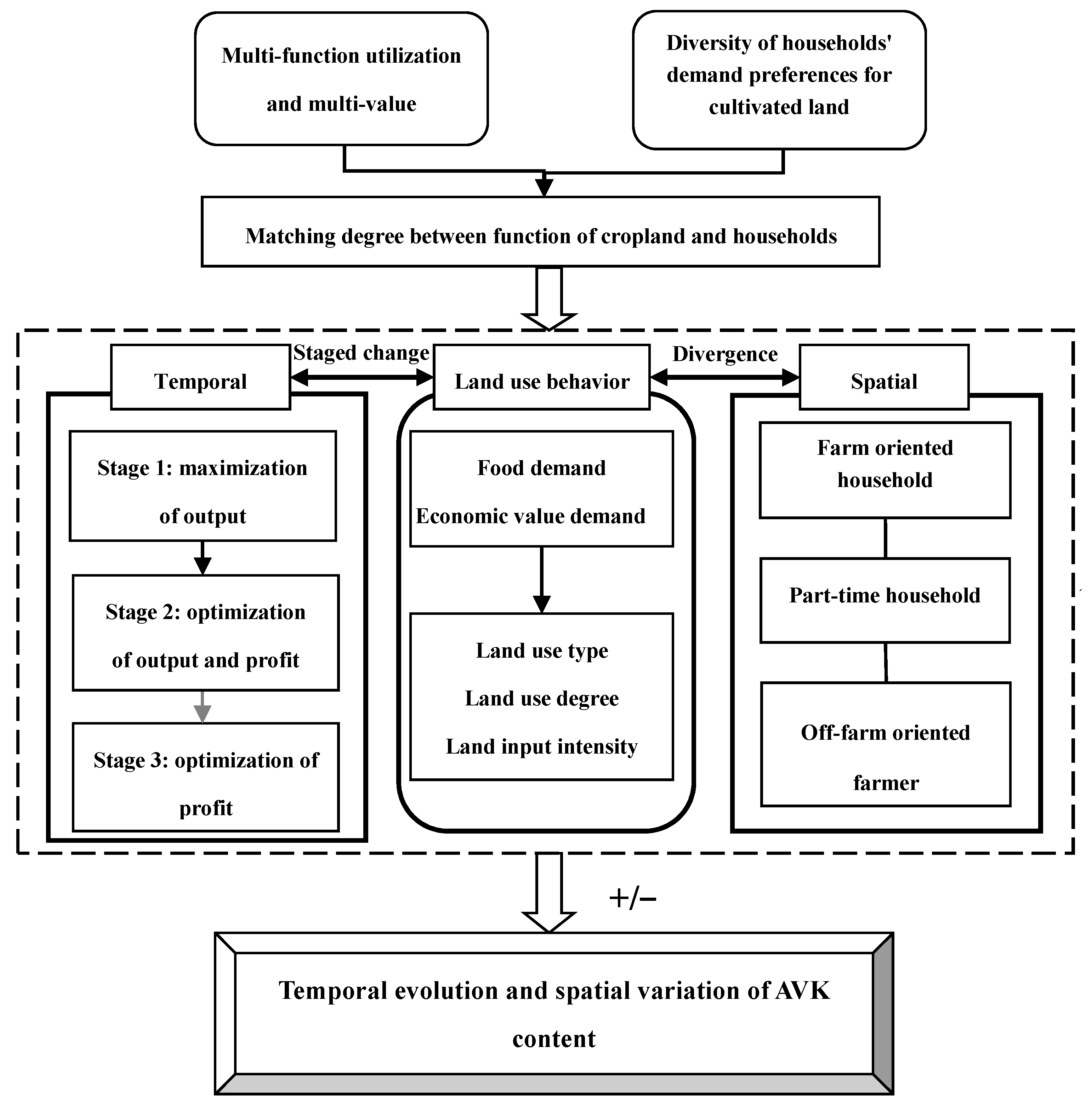
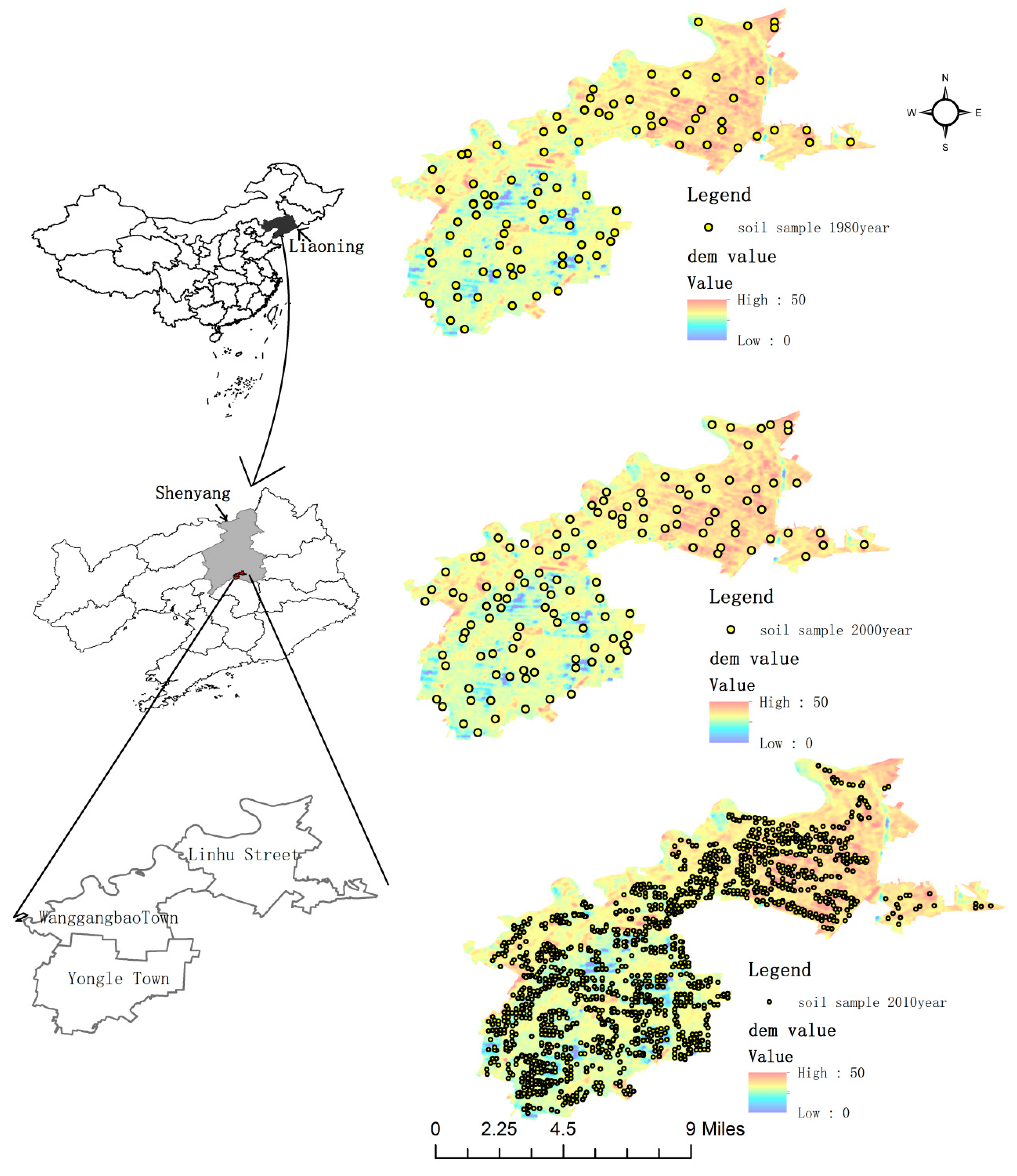
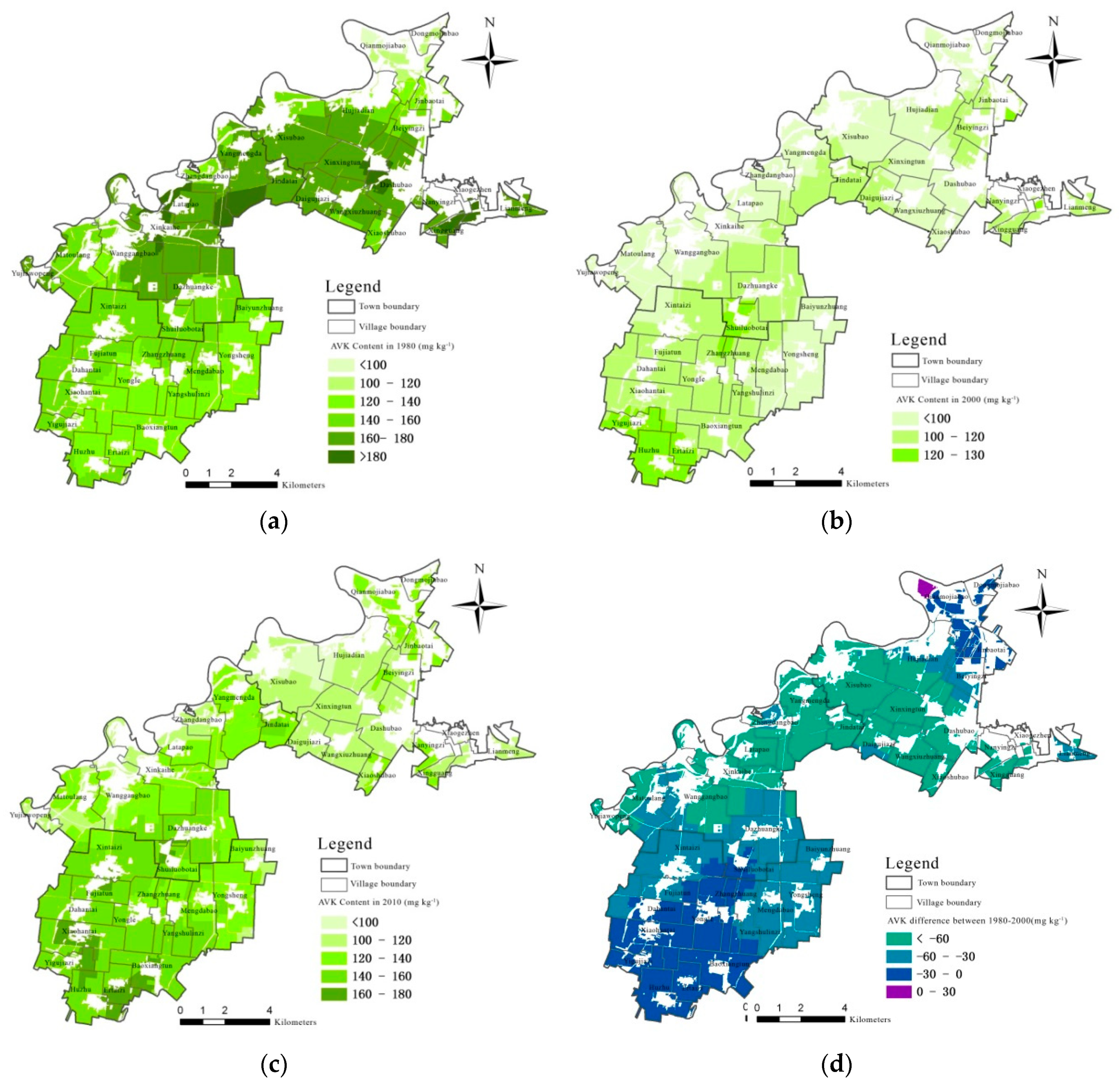
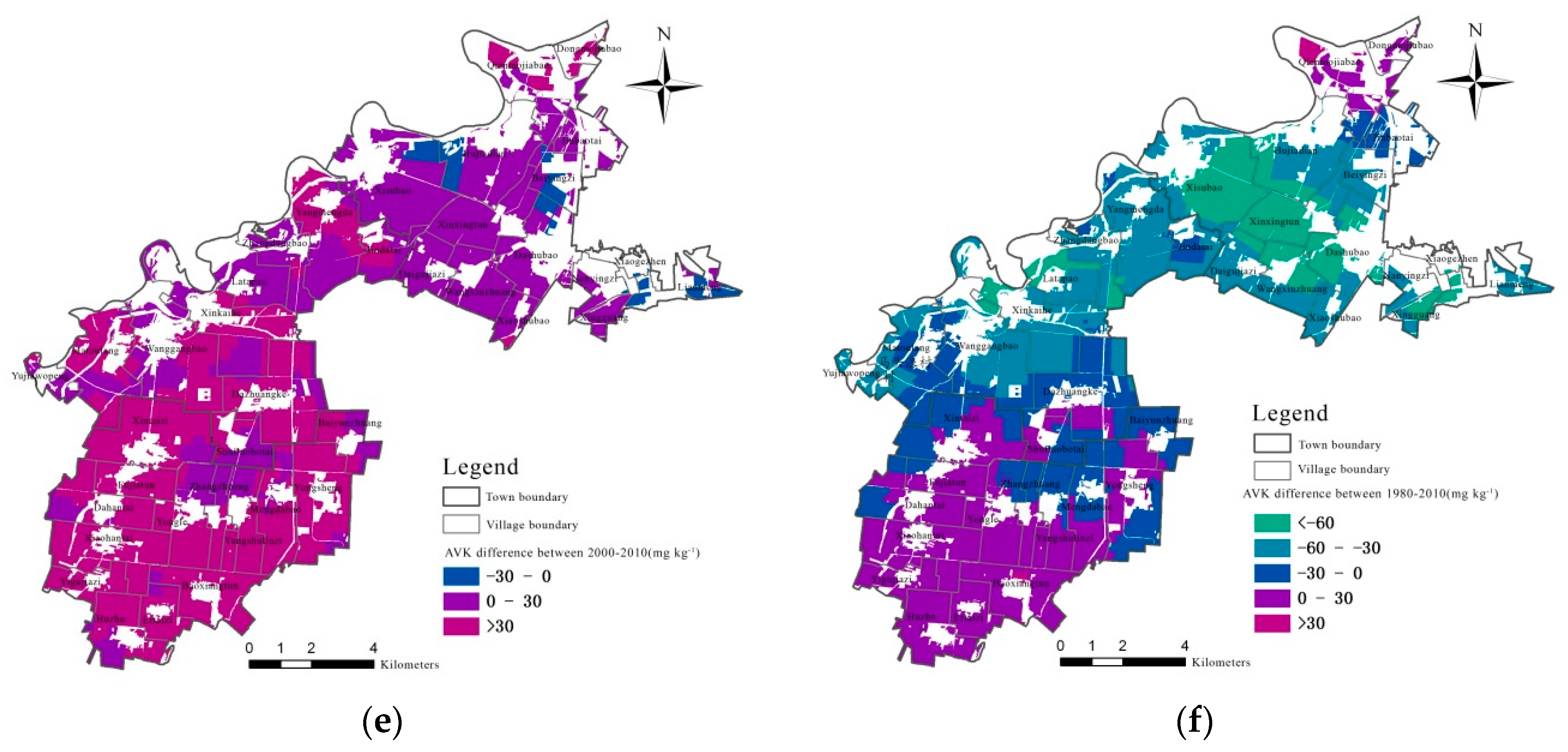
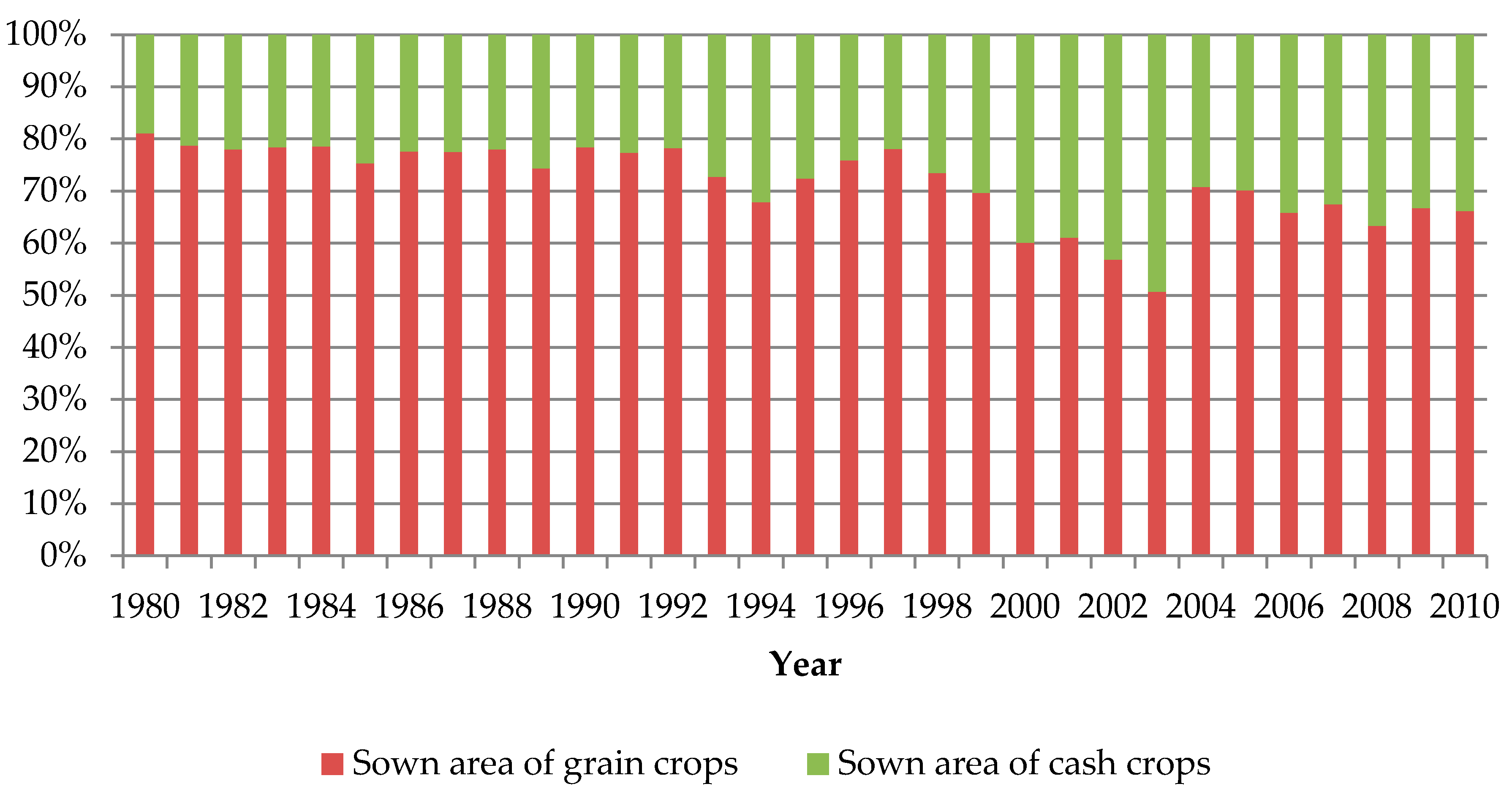
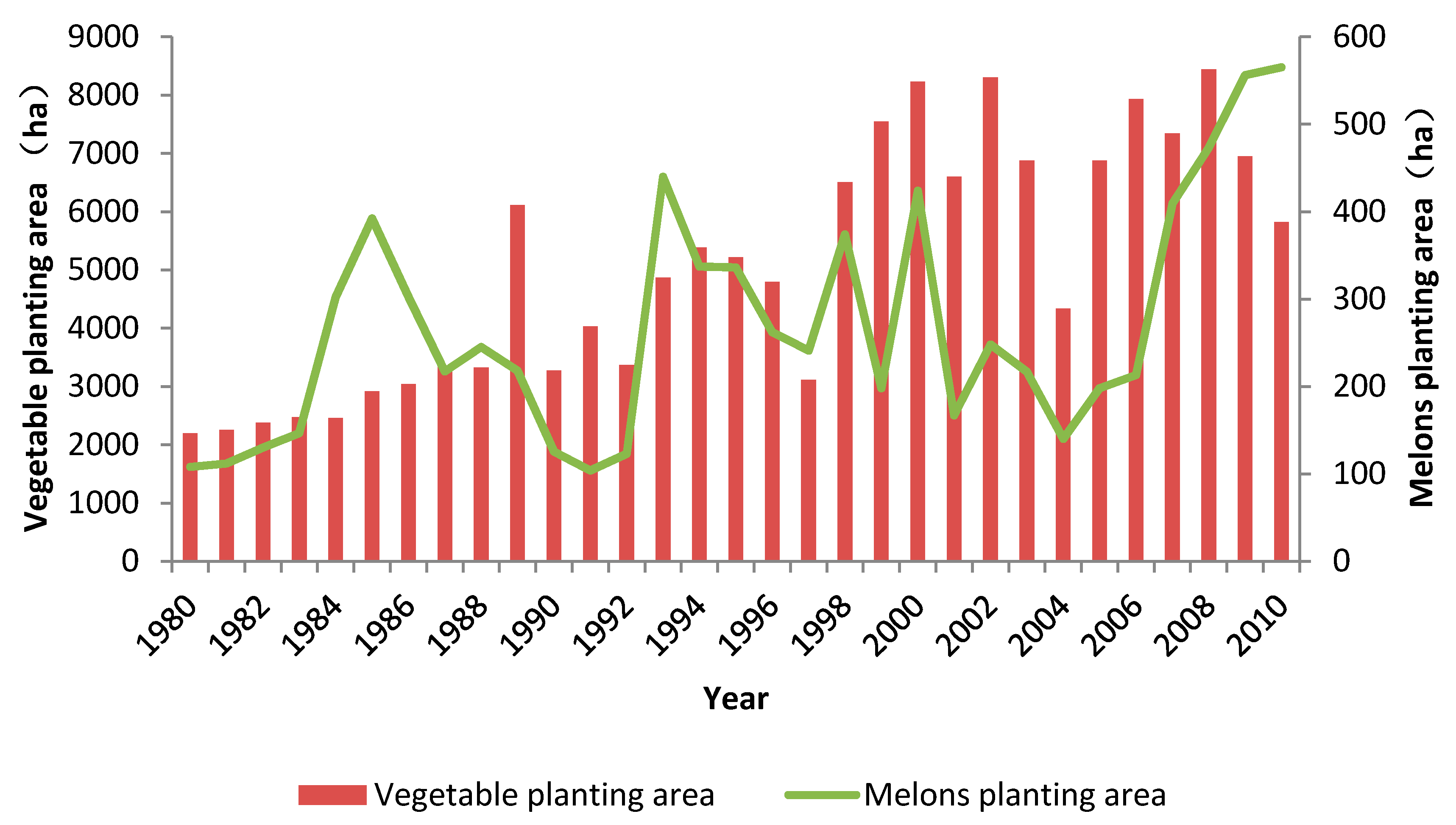
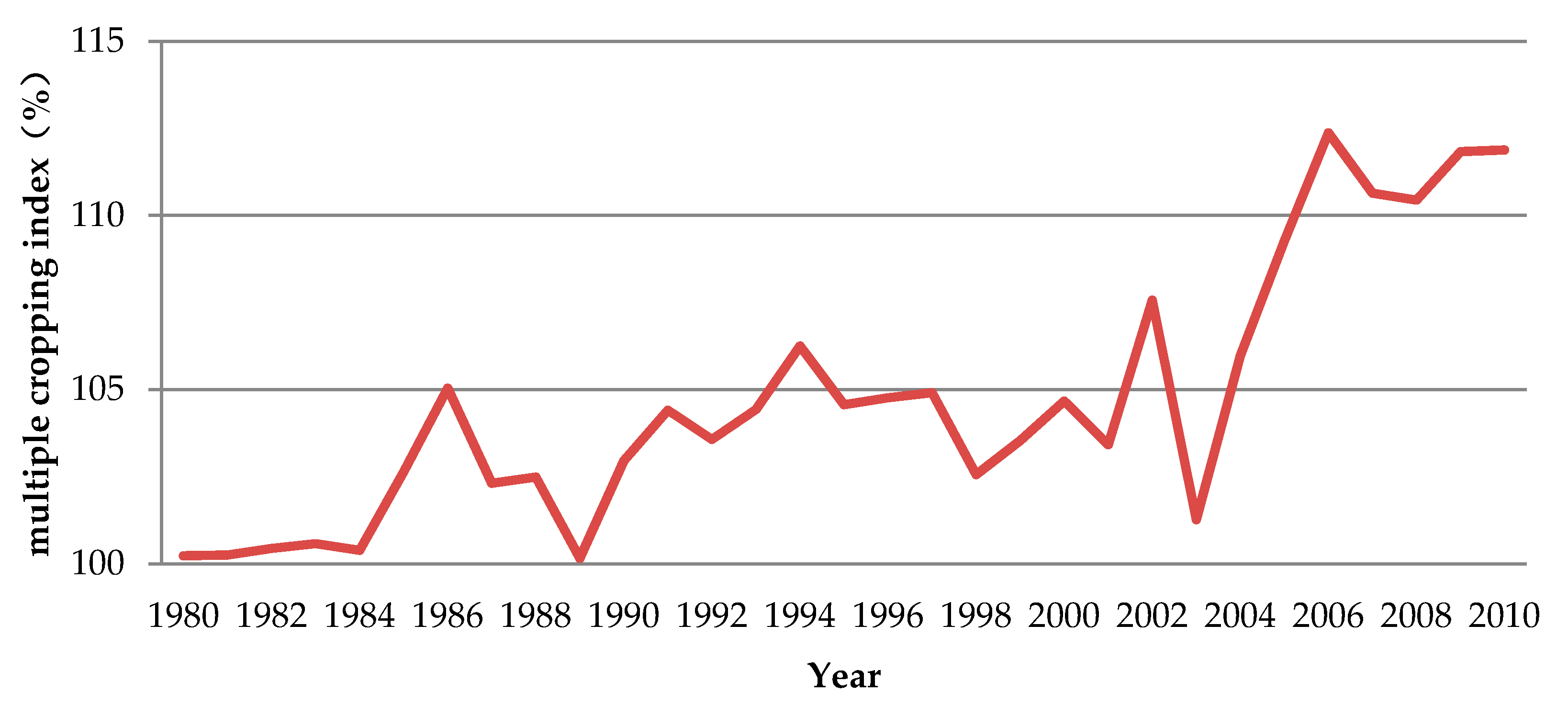
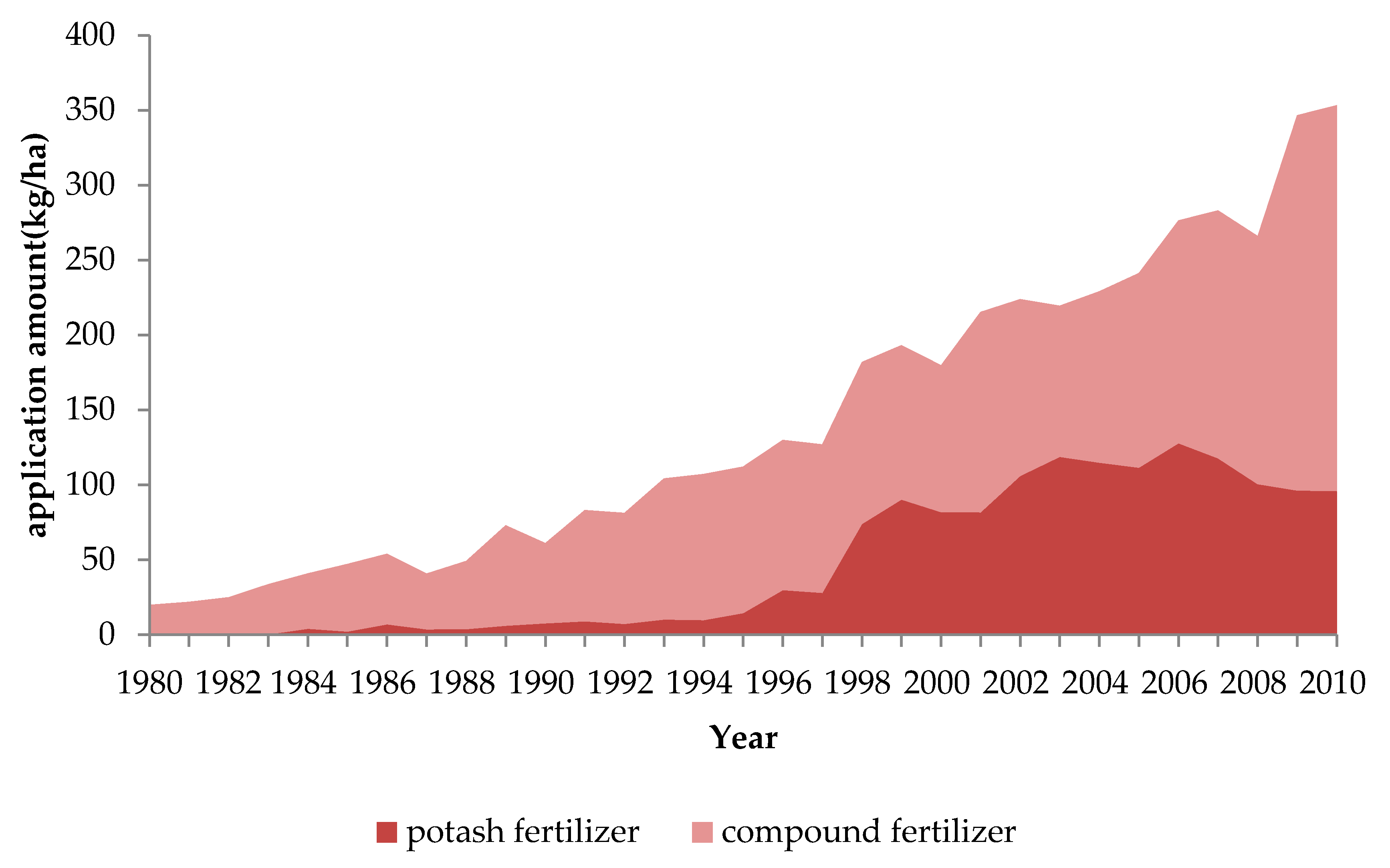
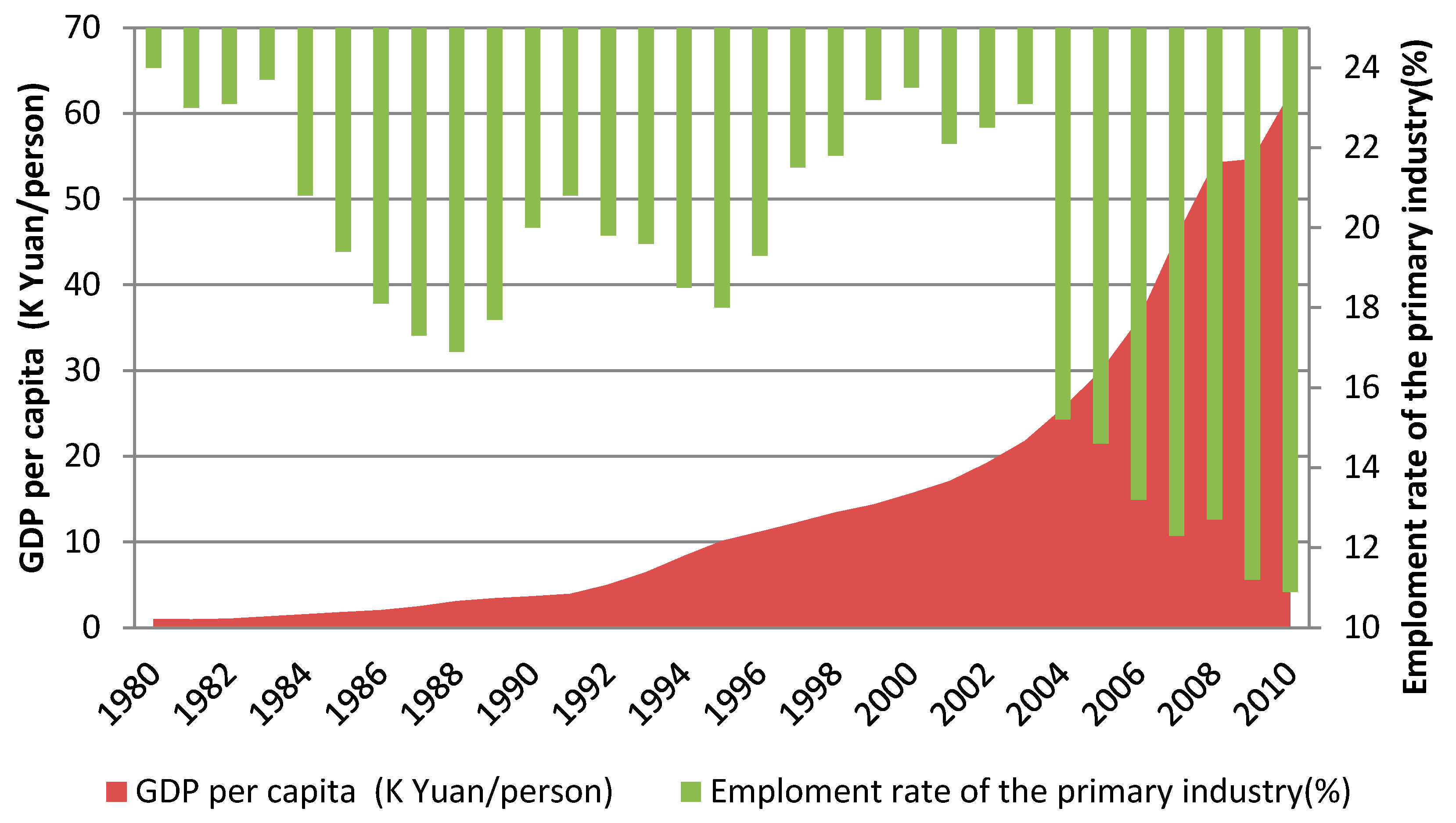
| Region | Level | Content | In 1980 | In 2000 | In 2010 | |||
|---|---|---|---|---|---|---|---|---|
| Area (ha) | Ratio (%) | Area (ha) | Ratio (%) | Area (ha) | Ratio (%) | |||
| Linhu Street | I | ≥180 | 183 | 1.6 | —— | —— | —— | —— |
| II | 160–180 | 1923 | 17.1 | —— | —— | —— | —— | |
| III | 140–160 | 684 | 6.1 | —— | —— | —— | —— | |
| IV | 120–140 | 147 | 1.3 | 34 | 0.3 | 559 | 5.0 | |
| V | 100–120 | 164 | 1.5 | 1037 | 9.2 | 2314 | 20.6 | |
| VI | <100 | 66 | 0.6 | 2097 | 18.7 | 295 | 2.6 | |
| Wanggangbao Township | I | ≥180 | 343 | 3.1 | —— | —— | —— | —— |
| II | 160–180 | 1976 | 17.6 | —— | —— | 35 | 0.3 | |
| III | 140–160 | 1146 | 10.2 | —— | —— | 778 | 6.9 | |
| IV | 120–140 | 117 | 1.0 | 123 | 1.1 | 2135 | 19.0 | |
| V | 100–120 | —— | —— | 1673 | 14.9 | 634 | 5.7 | |
| VI | <100 | —— | —— | 1785 | 15.9 | —— | —— | |
| Yongle Township | I | ≥180 | —— | —— | —— | —— | —— | —— |
| II | 160–180 | —— | —— | —— | —— | 492 | 4.4 | |
| III | 140–160 | 1930 | 17.2 | —— | —— | 2879 | 25.7 | |
| IV | 120–140 | 2542 | 22.7 | 699 | 6.2 | 976 | 8.7 | |
| V | 100–120 | —— | —— | 2619 | 23.3 | 124 | 1.1 | |
| VI | <100 | —— | —— | 1154 | 10.3 | —— | —— | |
| Total | I | ≥180 | 526 | 4.7 | —— | —— | —— | —— |
| II | 160–180 | 3899 | 34.7 | —— | —— | 522 | 4.7 | |
| III | 140–160 | 3760 | 33.5 | —— | —— | 3663 | 32.6 | |
| IV | 120–140 | 2806 | 25.0 | 856 | 7.6 | 3670 | 32.7 | |
| V | 100–120 | 164 | 1.5 | 5329 | 47.5 | 3070 | 27.4 | |
| VI | <100 | 66 | 0.6 | 5036 | 44.9 | 295 | 2.6 | |
| Period | Area and Proportion | Range of Content Various (mg/kg) | ||||
|---|---|---|---|---|---|---|
| < −60 | −60–−30 | −30–0 | 0–30 | >30 | ||
| 2010–1980 | Area (ha) | 1595 | 3334 | 2721 | 3512 | 57 |
| Proportion (%) | 14.22% | 29.72% | 24.25% | 31.30% | 0.51% | |
| 2000–1980 | Area (ha) | 4508 | 3843 | 2826 | 43 | - |
| proportion (%) | 40.17% | 34.25% | 25.19% | 0.39% | - | |
| 2010–2000 | Area (ha) | - | - | 340 | 5092 | 5788 |
| proportion (%) | - | - | 3.03% | 45.38% | 51.59% | |
| Land–Use Behavior | Classification | Linhu Street | Wanggangbao Township | Yongle Township | Total | |||||
|---|---|---|---|---|---|---|---|---|---|---|
| Obs | Proportion % | Obs | Proportion % | Obs | Proportion % | Obs | Proportion % | |||
| GCC | Grain crops only | 74 | 93.7 | 23 | 29.5 | 2 | 2.5 | 115 | 48.3 | |
| Both grain crops and cash crops | 1 | 1.3 | 35 | 44.9 | 31 | 38.3 | 50 | 21.0 | ||
| Cash crops only | 4 | 5.10 | 20 | 25.6 | 48 | 59.2 | 73 | 30.7 | ||
| MCI | 1.0 | 74 | 93.7 | 39 | 50.0 | 2 | 2.5 | 115 | 48.3 | |
| 1.0–1.5 | 3 | 3.8 | 26 | 33.3 | 22 | 27.2 | 51 | 21.4 | ||
| 1.5–2.0 | 0 | 0 | 5 | 6.4 | 32 | 39.5 | 37 | 15.6 | ||
| 2.0–2.5 | 0 | 0 | 3 | 3.9 | 12 | 14.8 | 15 | 6.3 | ||
| 2.5–3.0 | 2 | 2.5 | 5 | 6.4 | 13 | 16.0 | 20 | 8.4 | ||
| LII | self–employed (day per mu) | 0–10 | 56 | 70.9 | 29 | 37.2 | 19 | 23.5 | 104 | 43.7 |
| 10–20 | 19 | 24.1 | 40 | 51.3 | 26 | 32.1 | 85 | 35.7 | ||
| 20–30 | 2 | 2.5 | 5 | 6.4 | 11 | 13.6 | 18 | 7.6 | ||
| >30 | 2 | 2.5 | 4 | 5.1 | 25 | 30.8 | 31 | 13.0 | ||
| employment (day per mu) | 0 | 47 | 59.9 | 63 | 80.8 | 9 | 11.1 | 119 | 50.0 | |
| 1–10 | 30 | 38.0 | 6 | 7.7 | 21 | 25.9 | 57 | 23.9 | ||
| 11–20 | 2 | 2.5 | 5 | 6.4 | 23 | 28.4 | 30 | 12.6 | ||
| >20 | 0 | 0.0 | 4 | 5.1 | 28 | 34.6 | 32 | 13.5 | ||
| capital investment (Yuan per mu) a | ¥0–500 ($0–74) | 72 | 91.1 | 38 | 48.7 | 9 | 11.1 | 119 | 50.0 | |
| ¥500–1000 ($74–128) | 6 | 7.6 | 17 | 21.8 | 7 | 8.6 | 30 | 12.6 | ||
| ¥1000–1500 ($128–222) | 1 | 1.3 | 16 | 20.5 | 9 | 11.1 | 26 | 10.9 | ||
| >¥1500(>$222) | 0 | 0 | 7 | 9.0 | 56 | 69.1 | 63 | 26.5 | ||
| Linhu Street | Wanggangbao Township | Yongle Township | |||||||
|---|---|---|---|---|---|---|---|---|---|
| B | t-value | Beta | B | t-value | Beta | B | t-value | Beta | |
| GCC | 61.205 *** | 2.702 | 0.399 | ||||||
| MCI | −15.469 * | −1.817 | −0.282 | ||||||
| LII | 0.009 * | 1.509 | 0.073 | 0.037 * | 1.884 | 0.225 | |||
© 2020 by the authors. Licensee MDPI, Basel, Switzerland. This article is an open access article distributed under the terms and conditions of the Creative Commons Attribution (CC BY) license (http://creativecommons.org/licenses/by/4.0/).
Share and Cite
Liu, H.; Sun, Z.; Luo, X.; Dong, X.; Wu, M. A Spatial-Temporal Analysis of the Effects of Households’ Land-use Behaviors on Soil Available Potassium in Cropland: A Case Study from Urban Peripheral Region in Northeast China. Land 2020, 9, 160. https://doi.org/10.3390/land9050160
Liu H, Sun Z, Luo X, Dong X, Wu M. A Spatial-Temporal Analysis of the Effects of Households’ Land-use Behaviors on Soil Available Potassium in Cropland: A Case Study from Urban Peripheral Region in Northeast China. Land. 2020; 9(5):160. https://doi.org/10.3390/land9050160
Chicago/Turabian StyleLiu, Hongbin, Zhanli Sun, Xiaojuan Luo, Xiuru Dong, and Mengyao Wu. 2020. "A Spatial-Temporal Analysis of the Effects of Households’ Land-use Behaviors on Soil Available Potassium in Cropland: A Case Study from Urban Peripheral Region in Northeast China" Land 9, no. 5: 160. https://doi.org/10.3390/land9050160
APA StyleLiu, H., Sun, Z., Luo, X., Dong, X., & Wu, M. (2020). A Spatial-Temporal Analysis of the Effects of Households’ Land-use Behaviors on Soil Available Potassium in Cropland: A Case Study from Urban Peripheral Region in Northeast China. Land, 9(5), 160. https://doi.org/10.3390/land9050160






